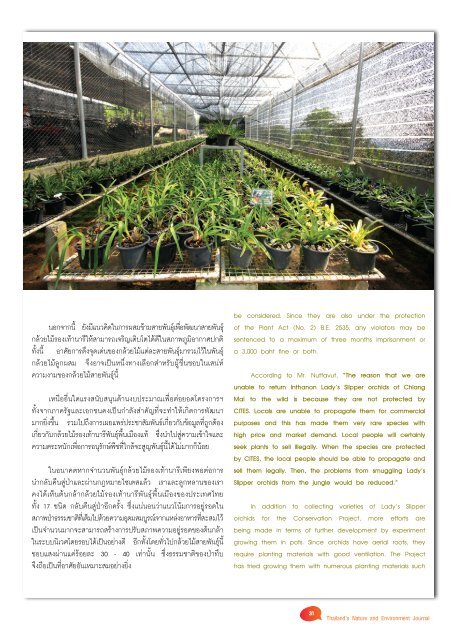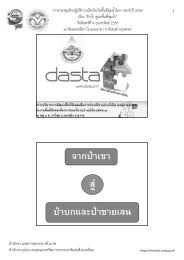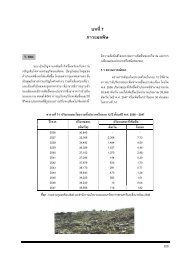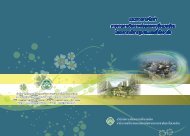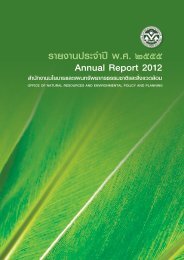ปีที่ 5 ฉบับที่ 3 กรกฎาคม-กันยายน 2552 - สำนักงานนโยบายและแผน ...
ปีที่ 5 ฉบับที่ 3 กรกฎาคม-กันยายน 2552 - สำนักงานนโยบายและแผน ...
ปีที่ 5 ฉบับที่ 3 กรกฎาคม-กันยายน 2552 - สำนักงานนโยบายและแผน ...
Create successful ePaper yourself
Turn your PDF publications into a flip-book with our unique Google optimized e-Paper software.
นอกจากนี้ ยังมีแนวคิดในการผสมข้ามสายพันธุ์เพื่อพัฒนาสายพันธุ์<br />
กล้วยไม้รองเท้านารีให้สามารถเจริญเติบโตได้ดีในสภาพภูมิอากาศปกติ<br />
ทั้งนี้ อาศัยการดึงจุดเด่นของกล้วยไม้แต่ละสายพันธุ์มารวมไว้ในพันธุ์<br />
กล้วยไม้ลูกผสม จึงอาจเป็นหนึ่งทางเลือกสําหรับผู้ชื่นชอบในเสน่ห์<br />
ความงามของกล้วยไม้สายพันธุ์นี้<br />
เหนืออื่นใดแรงสนับสนุนด้านงบประมาณเพื่อต่อยอดโครงการฯ<br />
ทั้งจากภาครัฐและเอกชนคงเป็นกําลังสําคัญที่จะทําให้เกิดการพัฒนา<br />
มากยิ่งขึ้น รวมไปถึงการเผยแพร่ประชาสัมพันธ์เกี่ยวกับข้อมูลที่ถูกต้อง<br />
เกี่ยวกับกล้วยไม้รองเท้านารีพันธุ์พื้นเมืองแท้ ซึ่งนําไปสู่ความเข้าใจและ<br />
ความตระหนักเพื่อการอนุรักษ์พืชที่ใกล้จะสูญพันธุ์นี้ได้ไม่มากก็น้อย<br />
ในอนาคตหากจํานวนพันธุ์กล้วยไม้รองเท้านารีเพียงพอต่อการ<br />
นํากลับคืนสู่ป่าและผ่านกฎหมายไซเตสแล้ว เราและลูกหลานของเรา<br />
คงได้เห็นต้นกล้ากล้วยไม้รองเท้านารีพันธุ์พื้นเมืองของประเทศไทย<br />
ทั้ง 17 ชนิด กลับคืนสู่ป่าอีกครั้ง ซึ่งแน่นอนว่าแนวโน้มการอยู่รอดใน<br />
สภาพป่าธรรมชาติที่เต็มไปด้วยความอุดมสมบูรณ์จากแหล่งอาหารที่สะสมไว้<br />
เป็นจํานวนมากจะสามารถสร้างการปรับสภาพความอยู่รอดของต้นกล้า<br />
ในระบบนิเวศโดยรอบได้เป็นอย่างดี อีกทั้งโดยทั่วไปกล้วยไม้สายพันธุ์นี้<br />
ชอบแสงผ่านแค่ร้อยละ 30 - 40 เท่านั้น ซึ่งธรรมชาติของป่าทึบ<br />
จึงถือเป็นที่อาศัยอันเหมาะสมอย่างยิ่ง<br />
be considered. Since they are also under the protection<br />
of the Plant Act (No. 2) B.E. 2535, any violators may be<br />
sentenced to a maximum of three months imprisonment or<br />
a 3,000 baht fine or both.<br />
According to Mr. Nuttavut, “The reason that we are<br />
unable to return Inthanon Lady’s Slipper orchids of Chiang<br />
Mai to the wild is because they are not protected by<br />
CITES. Locals are unable to propagate them for commercial<br />
purposes and this has made them very rare species with<br />
high price and market demand. Local people will certainly<br />
seek plants to sell illegally. When the species are protected<br />
by CITES, the local people should be able to propagate and<br />
sell them legally. Then, the problems from smuggling Lady’s<br />
Slipper orchids from the jungle would be reduced.”<br />
In addition to collecting varieties of Lady’s Slipper<br />
orchids for the Conservation Project, more efforts are<br />
being made in terms of further development by experiment<br />
growing them in pots. Since orchids have aerial roots, they<br />
require planting materials with good ventilation. The Project<br />
has tried growing them with numerous planting materials such<br />
31<br />
Thailand’s Nature and Environment Journal


